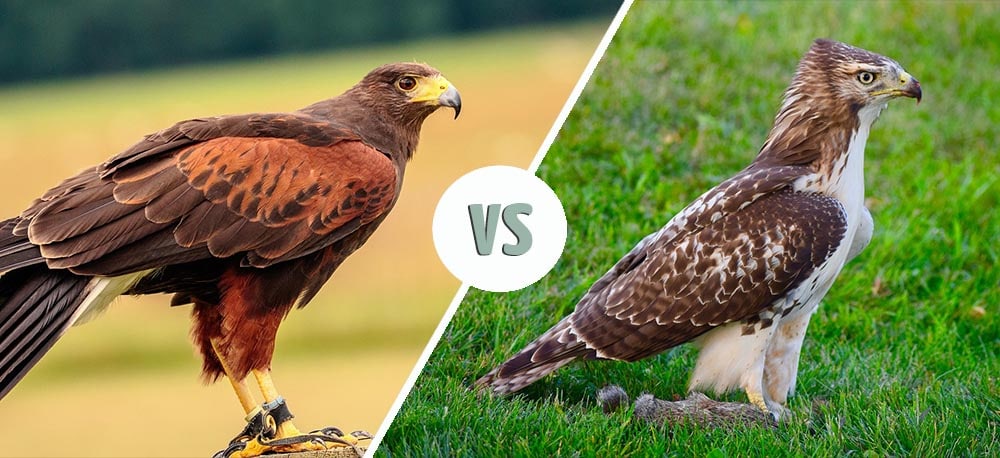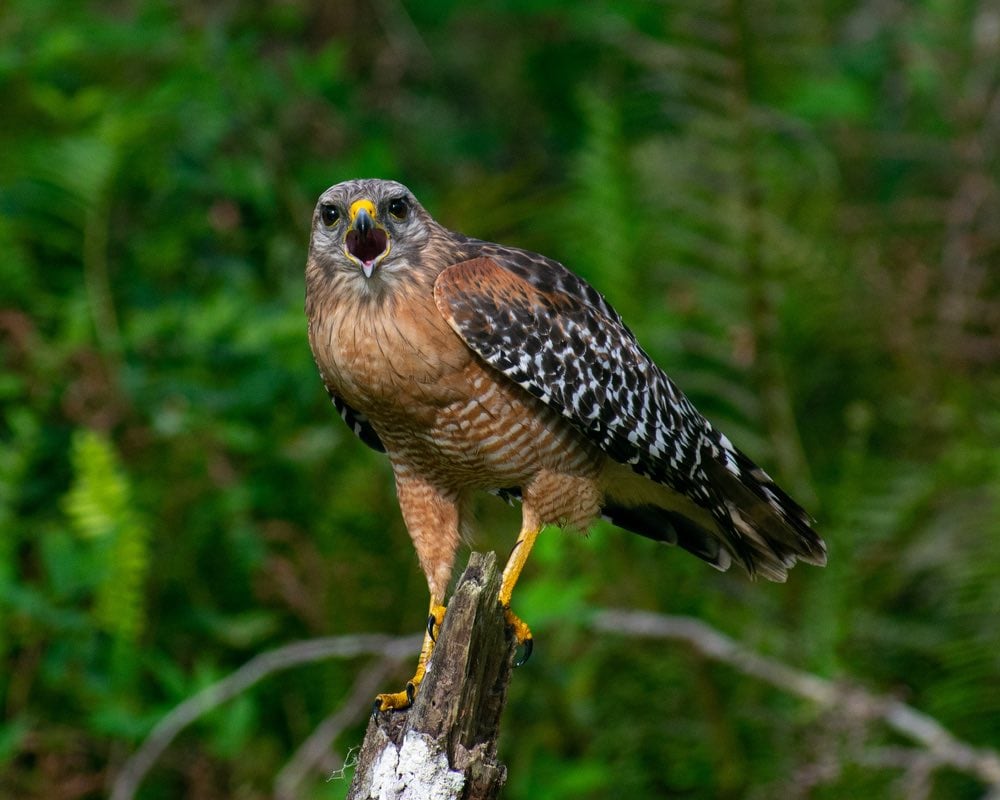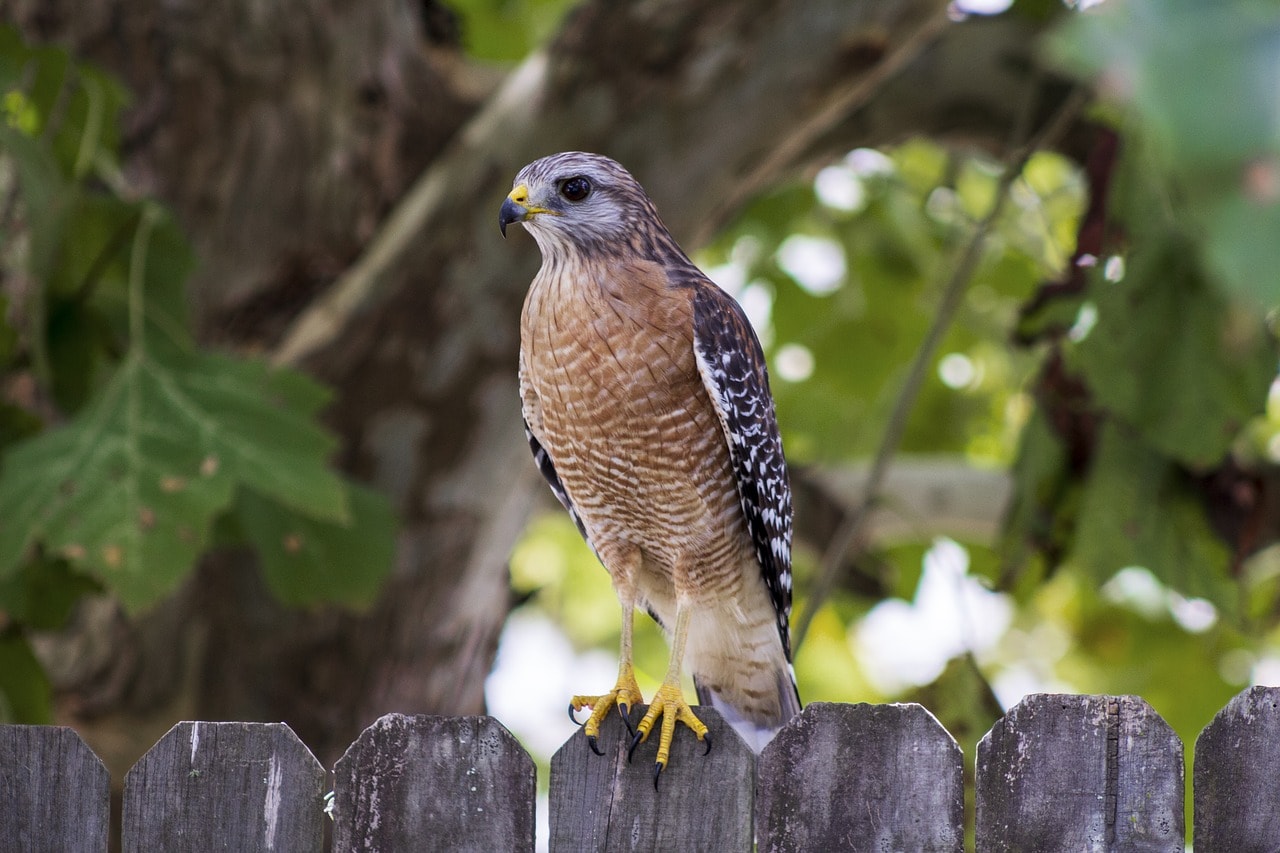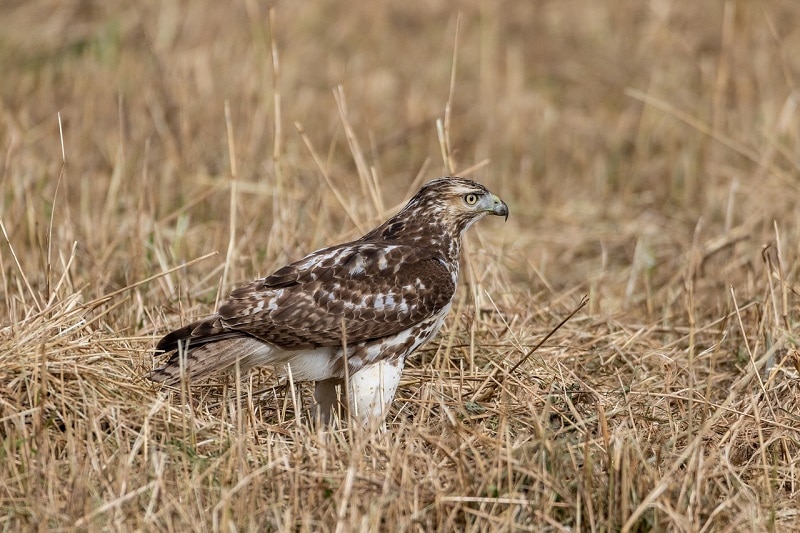Red-Shouldered vs. Red-Tailed Hawks: What’s The Difference?
Last Updated on

We’re going to talk about raptors here—birds of prey that hunt, kill, and feed on other animals. But to be specific, we’ll be talking about red-shouldered hawks and their close cousins, the red-tailed hawks. You’ll get to learn all there is to learn about their typical habitats, distinguishable traits, feeding habits, and maybe nesting behavior.
But before we even get into all that, for the sake of context, we feel it’s important to first talk about birds of prey in general. What are they, and how are they any different from other birds?
Birds of Prey
Growing up, we used to see birds eat insects, berries, seeds, fruits, and you know, the usual stuff. It’s not until we started exploring the wild that we learned that some birds are actually into hunting and love eating meat. They’d hunt other birds, mammals, and even fish depending on the season. These types of birds are what we’re referring to as Birds of Prey, also known as raptors.
A bird of prey is very distinguishable from other birds. They all have strong, hooked bills, and very powerful talons. In addition, they are often larger in size, and display a type of camouflage commonly referred to as countershading.
It’s also important to note that they’re normally grouped into two: Night hunters and the kind that prefer hunting during the day. An owl is a fine example of a night raptor, while the red-tailed and red-shouldered hawks represent the daytime hunters.
And now that we’re all caught up, let’s move on to our main topic of discussion today:

At a Glance

The Red-Shouldered Hawk

Buteo is a scientific term that’s usually used by ornithologists—someone who studies birds—when referring to a group of birds that have broad wings, and are well adapted to soaring. The red-shouldered hawk is a buteo, ipso facto, a soaring hawk.
It’s really not difficult to mistake this bird for any other species, if you’re an avid birdwatcher because its upper shoulder has rust-colored patches all over. Rust kind of looks red in color, hence the name red-shouldered hawk.
But then again, we’ve noticed some regional differences. The red-shouldered hawks found in California have rusty heads, and are very richly colored. Move to Florida, and you’ll realize the hawks there are all somehow pale, and have grayish heads. In Northeast, they all just brown in general.
Range and Migration
Spotting a red-shouldered hawk in North America is… normal. Of course, California residents will disagree with us considering the bird’s population in that area is isolated, but many of them are found west of the Mississippi River, in New Jersey—where they’re year-round residents—and along the Atlantic Coast.
If you can’t travel to any one of those places, you could wait for winter and see them migrate to the south. Like every other buetos, red-shouldered hawks also flock up and migrate to warmer regions during that time of the year.
Habitat
Red-shouldered hawks are not the type of birds that you’ll find in an over-populated area or dry climate. They’re most comfortable in deciduous woodlands, close to swamps, and along rivers. In fact, if you spot an unusually large tree below the forest canopy, just climb up to its crotch or fork. You’ll most likely find its nest built there.
Courtship is a very entertaining process. You’ll see the male red-shouldered hawk fly upwards, make some strange sound as if it’s calling for something, and then steeply dive down. The female will then join him, and together, they’ll fly in circles over the nesting territory for a couple of minutes.
The nest is usually built both sexes, and it has to be 35-65’ above ground. The construction material includes sprigs of vegetation, moss, and mostly sticks. It’s actually a strong build because they sometimes use them for more than one season.

Breeding
The female red-shouldered hawk will lay 3 to 4 eggs every year. Some only lay two but that’s a rare case. The eggs are pale bluish-white in color, and they’ll be incubated for roughly 33 days. During that period, the male will bring in food, and take over the incubation task while the female eats.
Once the eggs hatch, the female will still stick around for one to three weeks. This is important for two reasons: One, the nestlings are usually too young to hunt for food, and Two, they still have to be protected from predators. So, while the female protects the nestlings, the male hunts and feeds them.
Protection Status
In the 1800’s, the red-shouldered hawks were quite common around the States. You could spot them anywhere, anytime. But then the human population started flourishing, and with that, came the search of more food sources. Hunting became the norm, and people quickly fell in love with how tasty the red-shouldered meat was. If the red-shouldered hawks were not being killed for food they were being killed for fun. And the situation only got worse when in the 1900s, organizations started setting up infrastructure in the wetlands and clearing the forests.
A survey was carried out in 1979, and it was discovered that there are only 100 nesting pairs left in the country. This discovery opened the government’s eyes to what was actually happening, so it finally decided to list red-shouldered hawks as threatened.
Less than a year later, we could only find a third of the original population. And that was a sign that we still needed stringent measures to be put in place to save this breeding population. In 1991, biologists reclassified them as endangered.
Today, we honestly don’t know the overall population trend, but the one thing that we know for sure is, forest fragmentation is still the primary cause of their habitat loss.

Red-Tailed Hawks

Even though these predators were first sighted and studied in Jamaica, they’re probably the most common type of the hawks in North America. And just like the red-shouldered hawks, they’re also scientifically classified under the buteo family.
What Makes Them Distinguishable?
These birds of prey have brick-colored tails, but within their species, you’ll also find subspecies that have different color variations. What we’re basically trying to tell you is, not every red-tailed hawk will have a brick-colored tail.
In some regions, the red-tailed hawk is simply known as the red hawk. In others, they’re called the buzzard hawks. But regardless of what you call them, one thing will never change for sure—the fact that they’re still the most keen-eyed and efficient hunters in any ecosystem.
Habitat
The red-tailed hawk is not the type of bird that you’d typically find close to a water body or deciduous woodlands. They prefer deserts or open fields that have high perching areas, which allow them to watch their prey from a distance.
But that doesn’t mean that if you put them in a tropical rainforest, or in regions defined by mountains, they’ll starve or go extinct. They’re also the most adaptable birds of prey that you’ll ever come across. Something that they’ve proved time and time again whenever humans inhabit and destroy their homes.
You might not know this yet, but you’ve probably spotted them perched on telephone poles or seizing mice by the roadside.
Breeding and Courtship
What happens during the courtship season? Some hysterical aerial acrobatics. It’s almost the same thing that the red-shouldered hawk does, but with exaggeration. In pairs, they’ll also fly in circles, before the male red-tailed hawk plunges into a deep dive. Now the difference between this dive and the red-shouldered dive, is the height gained and how the pair holds onto each other after the male goes back up. They’ll then spiral towards the ground together, and breeding begins.

We forget to mention this earlier, but you should know red-tailed hawks and red-shouldered hawks are monogamous and mate for life. The female will lay one to five eggs in a season, and the incubation period is four to five weeks. One other similarity that you should take a note of is the fact that both sexes take turns incubating the eggs. However, compared to their cousins, the female stays with the nestlings for a longer period after the eggs hatch.
Protection Status
There’s an act (the Federal Migratory Birds Treaty Act) that has been around since 1918, and it’s meant to protect different bird species, including the red-tailed hawk. So if you’ve been thinking about purchasing a red-hawk as a pet, or taking one from the wild, you shouldn’t.
First off, these birds have unusual dietary needs that you’ll never be able to take care of, and aggressive tendencies that you cannot tame. Secondly, you’ll run into trouble with the law. Falconers and rehabilitators are the only people allowed to own red-tailed hawks in the United States.

Conclusion
If you want to see red-shouldered and red-tailed hawks during summer, go out there and search their habitats. If you want to watch them during winter, buy a pair of binos, and wait for them to start migrating. And if you don’t know how to distinguish them, just go over the physical characteristics that we’ve talked about.
You might also be interested in:
Featured image credit: (L) Kevin, Pixabay | (R) sondinh2000, Pixabay
About the Author Robert Sparks
Robert’s obsession with all things optical started early in life, when his optician father would bring home prototypes for Robert to play with. Nowadays, Robert is dedicated to helping others find the right optics for their needs. His hobbies include astronomy, astrophysics, and model building. Originally from Newark, NJ, he resides in Santa Fe, New Mexico, where the nighttime skies are filled with glittering stars.
Related Articles:
Binocular Magnification Chart: Numbers & Distances Compared
How to Clean a Refractor Telescope: Step-by-Step Guide
How to Clean a Telescope Eyepiece: Step-by-Step Guide
How to Clean a Rifle Scope: 8 Expert Tips
Monocular vs Telescope: Differences Explained (With Pictures)
What Is a Monocular Used For? 8 Common Functions
How to Clean a Telescope Mirror: 8 Expert Tips
Brightfield vs Phase Contrast Microscopy: The Differences Explained
